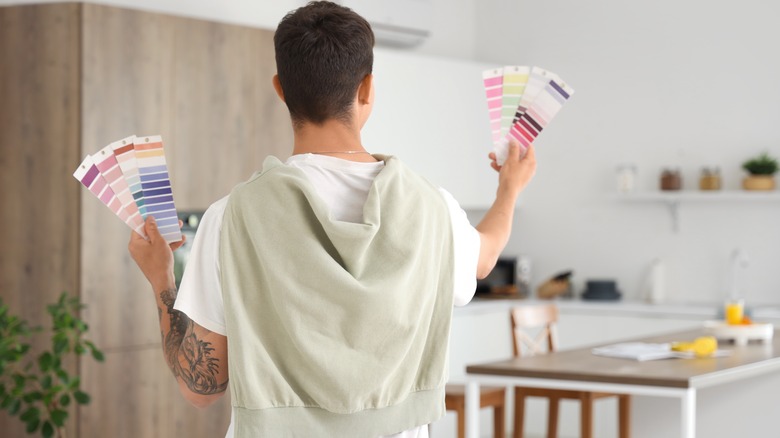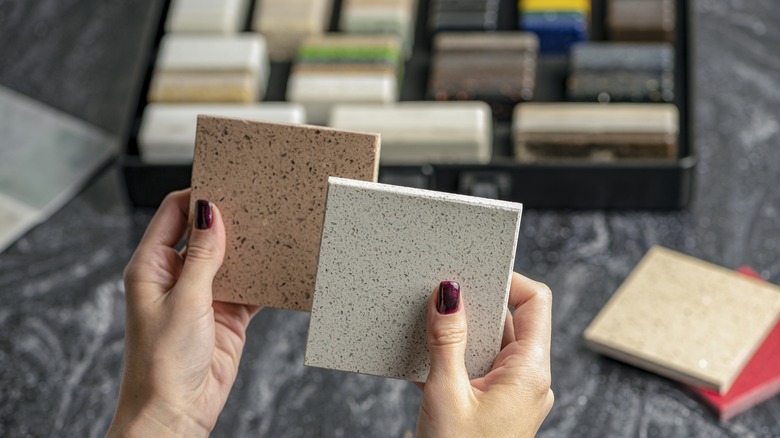How To Pick The Best Kitchen Paint Color To Pair With Your Quartz Countertops
When you poll strangers about what the best countertop material is, you'll often hear natural stone. In addition to granite and marble, quartz is a popular choice, which is engineered natural stone, made through a process in which quartz stones are crushed then compressed together. This offers you all of those natural stone tones of granite and marble, but at a fraction of the cost. The problem is that sometimes quartz can blend into the kitchen, lacking character and distinction, especially in popular all-white kitchens. One of the best ways to make sure your quartz countertops pop is by pairing them with a great paint color on the kitchen walls and/or cabinets.
Choosing the right color can be difficult, though. And given how time consuming and often expensive it can be to paint the kitchen, you don't want to make the wrong choice. To make sure you choose the right shade for your quartz countertop, it's essential to identify whether your quartz countertop is warm, neutral, or cool toned, and choose a color in the same family. Additionally, you can choose to highlight the background color or the veining and other cosmetic details to make for a truly stunning pairing.
How to identify the color temperature of your quartz
It's key to identify the color temperature of your quartz when choosing your paint colors. Pairing a cool-toned white quartz countertop with a yellowy beige paint color can make the walls look aged compared to the bright white of the counters, while choosing a pure white paint for warm-toned quartz is similarly off-putting. Basically, you want harmony in your color palettes. But it isn't always easy to know whether your quartz leans more warm, cool, or neutral. This may seem counterintuitive because they just contain natural, neutral stone colors like gray, black, white, and brown, right? Despite being called neutrals, that doesn't mean the color itself is neutral, temperature-wise.
To determine temperature, look for undertones. For instance, the difference between pure white and ivory is in undertones, with ivory containing hints of yellow, orange, or red, and pure white leaning cooler with shades of purple, green, and blue. If this is difficult for you to do on sight, try taking a photo of the countertop and uploading it to a photo editing program, and use the eyedropper tool. This will show you where the true colors of the countertop are on the color wheel, and you can find shades with similar temperature values. You can also hold paint samples against the countertop to help you identify similar shades. If you have fully neutral colors or have multiple temperatures, you can choose colors on either side of the spectrum.
Choosing complementary paint colors for quartz
Now that you've determined the color temperature, it's time to pick out specific paint colors and create a cohesive color palette for your quartz countertops. For a harmonious, complementary look, use paint chips again to help you identify the exact shade of the main color of the stone. Then, choose a few shades that are one to two shades lighter or darker than the countertop. This offers subtle contrast that will help the quartz countertops to stand out, while making for a very chic monochromatic palette. If you like your looks a little bolder, go for contrasting colors. White countertops pair well with dark paints, and darker stone will pop with less saturated, pastel paint colors.
Quartz, like marble and granite, can have lots of variation in veining and speckles, and you can play off of these for a more subtle accent color. If there are warm brown or gold veins, you can still pull off warmer paint like colors like Benjamin Moore's Navajo Red, even if the backdrop is a cooler toned white. On the opposite end of the spectrum, pull stony gray-blues such as Behr's Platinum, which offers blue-toned, silver undertones, for cooler toned speckled quartz counters.


